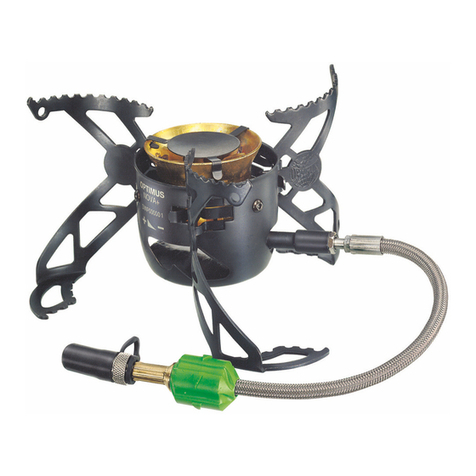
3
DANGER
This stove can be used with liquid pressurized gas (LPG) canisters or liquid fuels which
are highly flammable and explosive. Improper or unsafe use can result in accidental fire
and explosions which can cause serious injury or possible death.
• Use outdoors only.
• The Optimus Polaris stove is designed for optional use with Optimus gas canisters
containing 50% Butane / 25% Isobutane / 25% Propane with a threaded valve certified to
the EN 417 standard (max 450g). It is hazardous to attempt to fit other types of gas
canisters.
• Listen and smell for leaking gas. LPG is invisible and may be odorless, as its strong
odorant can fade over time. As a result, leaks are not always detectable by smell.
• If you suspect that there is a leak, do not use the stove or canister. To locate and stop the
leakage, move stove to a well-ventilated area outdoors away from any ignition source.
Check that the stove and fuel canister connection is secure and tight.
• Move the stove away from any spilled fuel.
• Do not use the stove if damaged or if it does not operate properly.
• Use extreme caution when using stove in temperatures below freezing. In freezing
temperatures, O-rings can stien and leak fuel.
• Always check for fuel leaks before and after lighting the stove.
• Keep children more than 3+ meters (10 feet) away from stove and fuel.
• Keep highly flammable fabrics away from stove, such as outdoor clothing, sleeping bags,
tents etc.
• Never leave a burning or hot stove unattended.
• Do not use for space heating.
• Always store fuel bottle tightly closed and gas canisters in cool, well ventilated areas away
from heat or ignition sources, such as water heaters, stoves, pilot lights, furnaces, and
electric devices. Use extreme caution when storing stove fuel.
WARNING
Risk of fire and explosion when using fire to detect fuel leaks.
• Only check for leaks using soapy water. Do not try to detect leaks using a flame.
• Always check the fuel connector O-ring before connecting a new fuel canister or fuel bottle
to the stove. Do not use the stove if O-ring is damaged or worn. FIGURE [1]
WARNING
If you expose the gas canister or fuel bottle to high heat, it could explode or leak.
• Keep stove, fuel canister and fuel bottle away from other heat sources.
• Follow all warnings on fuel canister regarding use and storage.
• Do not attach or remove canister near high heat, open flames, direct sunlight, other
ignition sources or where temperature of canister exceeds 50°C (120°F).


































